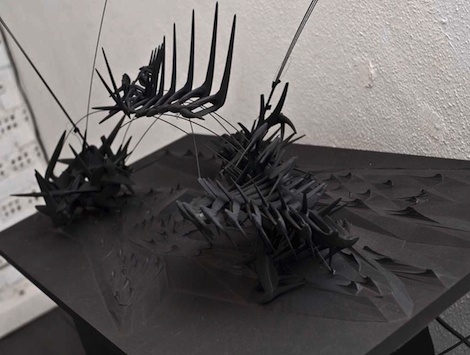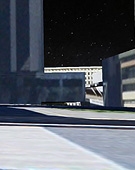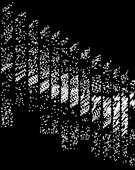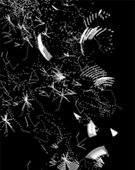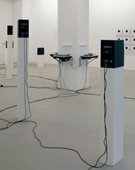Represents an idiosyncratic logic of designing based on a set of biologic principles involved in the production of an object and the accomplishment of an environment, which includes architecture and media. The exploration merges space and media through embryologic procedures, in order to create an ubiquitous spatial envelope. The work is a technical re-contextualization of biological elements and processes. These denote the genetic code of the object can be scripted and reproduced by means of communication. This departs from the premise that the code of the space is, to a certain extent, related to the artifact’s environmental experience. Hence the project evolves in a continuous media reconfiguration of its elements, along with an adaptive correspondence in the actual space. Thus Emosphera is an envelope of virtual and actual elements surrounding our existence. It is our embryological atmosphere.
Full Description
In parallel to the fusion of media and architecture dialogue, is the discourse of organic art and architecture where the same objective is part of the process. In this case an embryological process where the power of morphogenesis is not only in its form but also in its holistic system of communication. Thus the project develops a structure from an embryological field, both by tracking molecule movements and its consequent emergent sonic visual and geometrical elements. The evolutionary algorithm is inspired in embryological levels of materialization, where a number of molecules have different characteristics, such as life span, size and form. These are all part of our biological environment or atmosphere. The work also takes in to consideration the semantics of the word atmos “vapor” + sphaira “ball” and its original definition as “an envelope of gases surrounding the earth or another planet”, where we may extract an organic spatial logic. Hence the interest focus is not only in the pervading tone or mood of a place implied in the architectural definition, but also in the holistic understanding that thoroughly investigates the dynamics of an environment.
The dynamics and fusion of multiple media into one space has been thoroughly studied by Frederick J. Kiesler. Kiesler’s investigations into a multi-dimensional, space are in fact the beginnings of what would become a radically new concept of form and content appropriately called “Endless Space”. In the 1930’s entitled the “Correalist Theory" believes that the essence of reality is not in the “thing” itself, but in the way it correlates and orders itself to its environment, to its spatial dynamics and to its atmosphere. Kiesler also deemed that it was essential to disregard the boundaries that separate the different arts and media. These boundaries needed to be dissolved and proclaimed that painters, sculptors, and designers, driven away by functionalism, would return from exile to be welcomed by architecture.
Under modernist premises the static nature of the “box” and the machine driven ideal of architecture, forces a single guided functionalism on man, which is not Kiesler’s desired environment nor atmosphere. Since his death in 1965, his notion of Endless Space and his studies of the Endless House in particular, have resurfaced in recent architectural discourse. New technologies have emerged that are now provoking different questions regarding the methodologies, where digital and tectonic potentials withhold the concept of an ubiquitous and holistic space, in other words, an atmosphere. An example of this evolution is the H20 Pavilion by NOX, where the spatial dynamics are fully integrated in the sonic, visual and architectural design producing an endless atmosphere. The dynamics of a space rely on a system similar to the one of an atmosphere. The structure includes multiple layers, which act and react according to their own characteristics generating overall heuristic environments. Environments where multiple media include sonic, visual and spatial entities, defines the overall design. A design that still follows the semantics of the word “atmospheres”, where the vapors are active media directly related to the spherical or formal quintessence of the space.
Work metadata
- Year Created: 2011
- Submitted to ArtBase: Tuesday Sep 27th, 2011
- Original Url: http://www.f-flat.com/
-
Work Credits:
- Frederico Fialho Teixeira, primary creator
- Muge Belek, primary creator
- Collective: [f]FLAT Architectures
Take full advantage of the ArtBase by Becoming a Member
